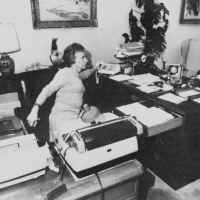Thomas Stockham and Digital Audio Recording
Thomas Greenway Stockham, Jr. was born in 1933. He earned the Sc.D. degree from MIT in 1959 and was appointed Assistant Professor of Electrical Engineering. At MIT in 1962 he began creating digital audio tape recordings using a large TX-0 computer and a A/D-D/A converter from Bernie Gordon at EPSCO. In 1963 he helped Amar Bose design the corner 2201 loudspeaker. In 1968 he left MIT for the University of Utah where his papers are now located, and in 1975 founded Soundstream with Malcolm Low (the L in KLH) and developed a 16-bit digital audio recorder using a high speed instrument magnetic tape recorder. Soundstream, Inc. was the first commercial digital recording company in the United States, located in downtown Salt Lake City. Companies such as Denon had been experimenting with digital recording since 1971, but Stockham was the first to make a commercial digital recording, using his own Soundstream recorder in 1976 at the Santa Fe Opera, and demonstrating the recordings at the fall 1976 AES convention. The first commercial digital recording to be released for sale was by Telarc of Frederick Fennell and the Cleveland Symphonic Winds, recorded in spring, 1978. Jack Renner of Telarc released the first CD of a digital recording in the U.S. in 1982. Soundstream merged with Digital Recording Corporation in 1980 and became DRC/Soundstream, but from 1975-80 Stockham with the help of scientists such as Jules Bloomenthal made over 500 digital masters with a completely computerized editing system, and pioneered tapeless hard disk editing. Thomas A. Britton at Chalfont Records produced in 1979 the King's Row soundtrack album with the first digital audio cross-fades. Soundstream sold about 16 of its editing systems at $160,000 each that were used by companies such as Bertelsmann. These machines used a Honeywell 16-track transport and sampled at 50 KHz. Stockham played a key role in the digital restoration of Enrico Caruso recordings, described in a 1975 IEEE paper "Blind Deconvolution Through Digital Signal Processing." He helped in the 1974 effort to recover the 18-minute tape gap made by Rosemary Woods on President Richard Nixon's White House tape: Rosemary Woods Rosemary Woods |
"We did a very thorough job trying to recover it. Unfortunately, it was erased by a stenographer's recorder which has a double erase head, and absolutely no human voice sounds were there except in a couple of places where the instrument used was stopped and then started again. But it was obvious, in the final analysis, that the gaps were created by the pushing of a manual button on the recorder. Also obvious was the way in which it was done; without a doubt, it had to have been done by a finger pushing this manual button." (quote from Levitin)
Stockham developed the first homomorphic compander to digitally filter noise from recorded sound, similar to the noise reduction devices of DBX and Dolby. After he left the Soudstream company, he was chairman of Electrical and Computer Engineering at the University of Utah. He was named a Fellow of the IEEE and served as president of the Audio Engineering Society in 1982-1983. He has received numerous awards for his contributions to audio technology, including the Poniatoff Gold Medal from SMPTE, the Gold Medal from the AES, an Emmy in 1988 for the development of tapeless audio recording and editing technology used in television studios. The NARAS awarded him a Grammy in 1994 for his "visionary role in pioneering and advancing the era of digital recording; using his Soundstream system, he was the first to digitally record music for commercial release; his numerous innovations have profoundly impacted recording and preservation technology, establishing him as the father of digital recording." The Academy of Motion Picture Arts and Sciences in Feb. 1999 awarded Stockham and Robert B. Ingebretsen a 1998 Scientific and Engineering Award "for their pioneering work in the areas of waveform editing, crossfades and cut-and-paste techniques for digital audio editing."
Obituary January 7, 2004 from Salt Lake Tribune.
Sources:
© 1999-2004 by Steven E. Schoenherr. All rights reserved.
|
Return to Recording Technology History Notes | Digital Revolution | this page revised 1/10/04